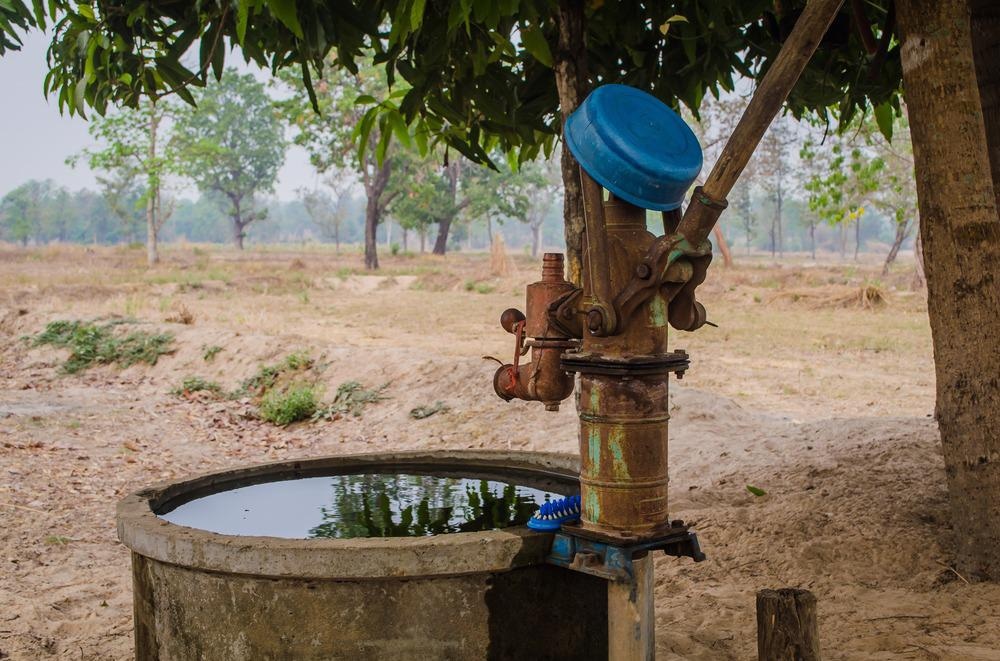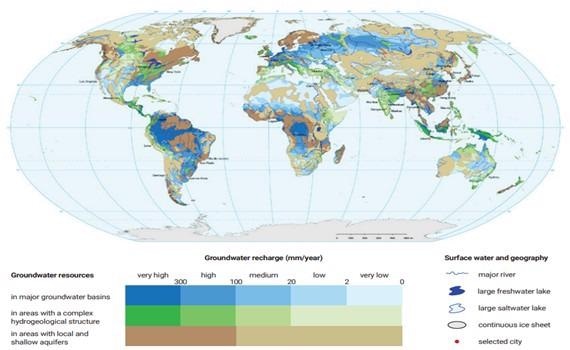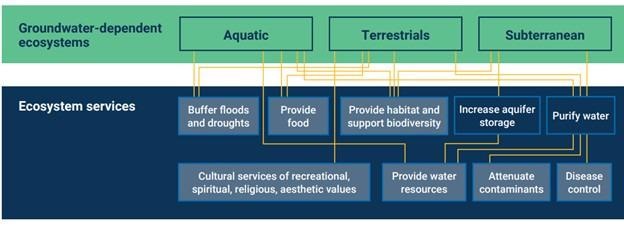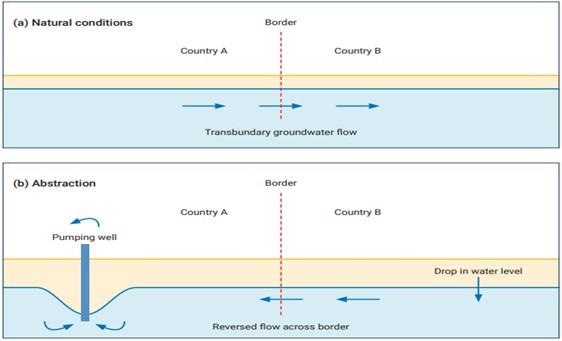This article will focus on the core findings of the United Nations World Water Development Report 2022.

Image Credit: pangploy/Shutterstock.com
What the Report Aims to Achieve
The report aims to provide a better knowledge of how groundwater affects people's daily lives and the best ways to make the most of this abundant yet vulnerable resource in the long term.
It strives to highlight groundwater's unique roles and problems in the worldwide development, management, and governance of water resources.
What the Report Looks At
The paper outlines the challenges and opportunities that come with developing, managing, and governing groundwater worldwide.
It discusses:
- How to make better use of the potential of still-underdeveloped groundwater resources
- How to protect groundwater from pollution and overexploitation
- How to respond dynamically to the needs of an ever-growing population
- How to respond effectively to global climate and energy crises
- The critical role of groundwater in achieving sustainable development
- The policy and management actions that must be taken to ensure the resource's perenniality while also capitalizing on the numerous opportunities it provides in a fast-changing world of increased water demand and restricted freshwater resources
State of Groundwater Resources
There is a large amount of fresh groundwater beneath the surface of the Earth, but its availability and the conditions under which it can be drained vary greatly from place to place.

Groundwater resources of the world Image Credit: BGR/UNESCO (2008)
A simplified hydrogeological map of the world is shown in the picture above. The vast majority of the world's fresh groundwater is found in just a few large basins (blue). Unproductive groundwater basins are shown with a complicated hydrogeological structure (green). Unfavorable places for groundwater development are shown on the map by the third main unit (brown).
Groundwater withdrawal increased dramatically over the 20th century, reaching historic levels at the turn of the 21st century.
According to annual reports, most countries' groundwater withdrawal rates have steadied or even decreased marginally. This is because, in some nations, groundwater withdrawal has reached intensities that make further expansion neither acceptable nor possible.
Challenges Related to Groundwater
As a result of ongoing natural and human activities, the groundwater is constantly affected, which has led to several groundwater-related issues worldwide.
Storage depletion
When groundwater discharge exceeds the recharge, storage depletion occurs, resulting in lower groundwater levels.
Increased prices and energy demands of groundwater abstraction, geological deformation, and increased water scarcity are the potential consequences of groundwater storage depletion.
Pollution
The appropriateness of extracted groundwater for drinking and other uses is reduced due to groundwater pollution, and ecosystems that rely on groundwater may also be affected.
Many anthropogenic activities can pollute groundwater, but most of them occur at or near the land's surface. However, several other sources discharge pollutants into the subsurface at higher depths. Pesticides, nitrates, and other agrochemicals are all common components of agricultural pollution, which is a pervasive problem.

Pollution sources that threaten groundwater quality. Image Credit: Villholth et al. (2011, fig. 2.6, p. 15)
Salination
Inundation of low-lying coastal terrain causes seawater to enter subsurface aquifers (geologic units capable of transmitting water under normal hydraulic gradients), displacing fresh groundwater with saline water.
A relatively stationary brackish or saline groundwater can start flowing toward the exploited fresh groundwater zone if groundwater abstraction occurs in coastal locations.
Irrigation is also a major contributor to groundwater salinity. This is because the crops withdraw the irrigation water and the dissolved solids remain behind in the soil, which is then flushed down along with saline groundwater reserves.
Problems with allocation, prioritization and access
Uncontrolled groundwater extraction by individuals or organizations for short-term financial gain may be seen in many places of the world. This results in the degradation of groundwater-dependent ecosystems.
Opportunities for Enhancing Benefits from Groundwater
Even though present groundwater extraction rates are unsustainable in some locations and will eventually decline, there are still several ways to increase the value of groundwater.
Unexploited groundwater potential
Aquifers in Sub-Saharan Africa, the Northern half of South America, Canada, and the Russian Federation, have untapped groundwater potential that is hardly exploited yet.
Unconventional groundwater resources
Salt-tolerant crops, aquaculture, and cooling systems can benefit from atypical groundwater sources such as brackish groundwater. Deep-seated fresh groundwater can be used if the deep-seated aquifers are sufficiently recharged. Drinking water can be obtained from offshore fresh groundwater subterranean freshwater springs.
Geothermal energy development
Groundwater provides chances for geothermal energy development. Despite recent improvements, this area of energy development is still in its early stages. Nevertheless, it will increase the worldwide advantages of groundwater and contribute significantly to the shift to greener energy and carbon neutrality.
Expanding anthropogenic replenishment of the groundwater buffer
An effective technical intervention, managed aquifer recharge (MAR), takes advantage of the sub-surface’s naturally accessible storage capacity. Extra water is temporarily stored and made available for later use to avoid wasting water.
Adapting To Climate Change and Mitigating Disasters
Groundwater's huge volume and its unique buffering ability provide significant promise for water supply security in climate change adaptation.
Groundwater resources' ability to buffer against short-term changes and shocks can assist and alleviate the effects of human-made and natural disasters and emergencies that directly affect surface water delivery systems.
Groundwater and Agriculture
Agriculture, cattle rearing, and food processing all rely on groundwater.
Even in semi-arid regions with low precipitation and surface water availability, its abstraction has significantly impacted food production since the 1970s.
Agricultural uses currently account for 70% of all global groundwater withdrawals, and an estimated 38% of all land that can be irrigated relies on this resource.
The development of groundwater could catalyze economic growth and improve agricultural productivity by increasing the size of irrigated areas to fulfill global water and agricultural demands by 2050, including a projected 50% increase in food.
Challenges of agriculture
It is estimated that agriculture has now polluted more groundwater than human settlements and industries combined in rural areas worldwide.
Anthropogenic contamination of groundwater, including nitrate from chemical and organic fertilizers, contributes to the eutrophication of surface waters worldwide.
The laws and regulations to prevent agricultural pollution from contaminating groundwater are often insufficient. However, it is possible to reduce pollution at the source through policies that promote information and awareness and encourage farmers to follow best management practices in agriculture.
Groundwater for Human Settlements
Most towns in suitable hydrogeological sites benefit from groundwater potential for their water supply, which increases water supply security greatly during extended droughts.
The development of well drilling methods in the 19th century enabled many people to exploit groundwater as a readily available, open-access resource.
It has become an important natural resource for human health and economic growth, but it is also a resource that is frequently misunderstood, undervalued, and insufficiently safeguarded.
Challenges
Overexploitation of groundwater in urban areas leads to land subsidence and saline-water intrusion, which have a negative impact on urban infrastructure.
According to recent estimates, nearly half of the world's urban population relies on groundwater, and this trend is expected to continue for many years to come.
On-site sanitation and groundwater supply cohabitation is a severe challenge for shallow sources, particularly in highly populated areas. Approximately 30% of rural groundwater sources in the United States are contaminated with pathogens.
Groundwater plays a significant role in urban and rural water supply and displaced people settlements; water utilities must place a much greater emphasis on protecting water wells and springhead sources to ensure the resource's sustainability.
Groundwater and Industry
Many industries rely on groundwater, contributing to employment and economic prosperity. In addition, groundwater resources are used in various industrial activities where surface water is scarce, yet the quality is critical.
Industries that withdraw groundwater include mining, manufacturing, energy generation, oil and gas, construction, and engineering. In addition, many manufacturing processes necessitate a substantial amount of water for product washing and cleaning after the manufacturing process.
The amount of water that may be withdrawn from the ground without harming domestic supply is becoming increasingly competitive and contested by local groups and municipalities.
The energy sector also impacts groundwater quality. For example, the leaching of coal ash from trash dumps into groundwater can impact groundwater quality. Groundwater contamination is also a serious issue associated with fracking for natural gas.
For hydrogeologists, governments, and water supply companies, mining can provide valuable information on the location and size of aquifers and their qualities.
Groundwater and Ecosystems
Groundwater discharge sustains the base flows of streams and rivers, a critical supply of water that affects their vulnerability to drying up during drought seasons.
Groundwater is essential to terrestrial ecosystems in all biomes across the world where plants can reach it. For example, groundwater is critical for the survival of the intricate food webs seen in arid landscapes such as savannahs because water holes in arid areas are often entirely dependent on it. In addition, groundwater is critical to riparian zones, wetlands, and other surface water bodies.
Spring, wetlands, and oases are drying up all over the world. Globally, groundwater depletion hotspots are commonly located in areas where irrigation uses groundwater intensively. As a result, ecosystems on land and water are equally impacted by the steady drop in water levels.
Groundwater-dependent ecosystems
Groundwater-dependent ecosystems (GDEs) are made up of plants, animals, and fungi that can be found in a wide range of environments. By facilitating biophysical processes such as filtration and biodegradation, GDEs serve a key role in safeguarding aquifers from contamination. Groundwater-dependent ecosystems are at threat due to groundwater depletion, climate change, and land-use changes.
Terrestrial and subsurface GDEs, in particular, are frequently left unprotected. An exception to this is the Ramsar Convention, a seven-step groundwater management structure designed to preserve the ecological character of worldwide-important wetland areas.

Connecting groundwater-dependent ecosystem types with the ecosystem services they provide. Image Credit: UNESCO (2022)
Groundwater, Aquifers and Climate Change
Global warming causes freshwater to be released from long-term storage in continental ice sheets and ocean thermal expansion, which contribute significantly to sea-level rise and increase saline water intrusion into coastal aquifers.
Climate change also affects permafrost distribution, streamflow seasonality, changing soil moisture, and the amount of water stored above and below ground.
The intensity of precipitation has been seen and widely observed to impact the replenishing process. Groundwater recharging is significantly enhanced in many locations when there are fewer but heavy rains. However, cholera outbreaks have been linked to recharging from high rainfall events in such areas.
Reduced groundwater recharge due to increased evaporation and decreased dilution in the Mediterranean region has resulted in increased concentrations of chloride, nitrate, and arsenic contaminants in shallow aquifers.
Climate change may have the biggest influence on groundwater through indirect effects on irrigation water demand, leading to groundwater depletion or contamination, affecting environmental flows.
The Resilience of Aquifer Systems to Climate Change
When it comes to long-term water storage and adaptation to climate change, aquifer storage is one of the best options available because of the reduced evaporative losses compared to other types of water delivery infrastructure, such as dams.
Aquifers that transport and store groundwater can also help mitigate climate change by using geothermal energy and absorbing and storing CO2.
Groundwater Management
Numerous obstacles and opportunities exist in groundwater management. To properly manage groundwater, it is necessary to consider the links between groundwater, society, the environment and ecosystems, and climate change.
Groundwater has traditionally gotten little management attention until a problem has become obvious. As a result, management has been reactive, and proactive approaches to groundwater management are essential to prevent resource deterioration and depletion.
Groundwater management must examine the numerous elements of groundwater systems, including groundwater storage, flows, quality, behavior, and the aquifer's structure and features.
While governments and their statutory agencies may lead overall groundwater management coordination, communities, water businesses, industry, farmers, and other individuals may also play vital roles.
A lack of data and understanding hampers evidence-based groundwater management. Groundwater management can only be successful if it is constantly monitored, assessed, and investigated. In addition, groundwater management's future success depends on reaching and engaging the next generation.
Governments must provide sufficient financial and political support and adequate mandates for the agencies that will play the main role in developing and sustaining groundwater management.
Transboundary Aquifers
Transboundary aquifers (aquifers that span two or more nations) demand special attention because groundwater pollution and variations in groundwater levels and pressures can affect the neighboring country.

Pumping groundwater from a well in country A can have an impact on the part of the aquifer in country B. Image Credit: Fraser et al. (2018, fig. 6, p. 45)
This approach has added a new international dimension to groundwater governance and management. The international community has recently begun recognizing their significance, allowing new opportunities to promote transboundary collaboration through dedicated financial resources. So far, six transboundary aquifers have formal interstate cooperation agreements and inventories conducted at the global and regional levels.
The Earth is home to hundreds of significant, cross-border aquifers. Many of them are linked to important freshwater habitats and represent a significant portion of global groundwater supplies. As a result, the establishment of transboundary aquifer cooperation must be prioritized.
Closing Thoughts
The total groundwater resources on Earth represent a massive supply of freshwater. But it continues to be vulnerable to overexploitation and contamination, both of which can have catastrophic consequences for the resource and its supply. Therefore, groundwater management and utilization must be strengthened and coordinated if its full potential is to be realized.
References and Further Reading
UNESCO. (2022). The World Water Development Report 2022 "Groundwater: Making the invisible, visible". [Online] United Nations Educational, Scientific and Cultural OrganizationAvailable at https://unesdoc.unesco.org/ark:/48223/pf0000380721
BGR/UNESCO (Bundesanstalt für Geowissenschaften und Rohstoffe/United Nations Educational, Scientific and Cultural Organization) (2008) WHYMAP. Groundwater Resources of the World. Map at scale 1: 25 000 000. Hannover/Paris, BGR/UNESCO. https://www.whymap.org/whymap/EN/Home/whymap_node.html
Foster, S. and Hirata, R. (2012) Groundwater use for urban development: Enhancing benefits and reducing risks. On the Water Front, Vol. 3, pp. 21–29.
Fraser, C. M., Kalin, R. M., Rivett, M. O., Nkhata, M. and Kanjaye, M. (2018) A national approach to systematic transboundary aquifer assessment and conceptualization at relevant scales: A Malawi case study. Journal of Hydrology: Regional Studies, Vol. 20. pp. 35–48. https://doi.org/10.1016/j.ejrh.2018.04.001
Taylor, R. G., Scanlon, B., Döll, P., Rodell, M., Van Beek, R., Wada, Y., Longuevergne, L., Leblanc, M., Famiglietti, J. S., Edmunds, M., Konikow, L., Green, T. R., Chen, J., Taniguchi, M., Bierkens, M. F. P., MacDonald, A. M., Fan, Y., Maxwell, R. M., Yechieli, Y., Gurdak, J. J., Allen, D. M., Shamsudduha, M., Hiscock, K., Yeh, P. J.-F., Holman, I. and Treidel, H. (2013) Ground water and climate change. Nature Climate Change, Vol. 3, pp. 322–329. doi.org/10.1038/nclimate1744
Villholth, K. G., Tøttrup, C., Stendel, M., Maherry, A. and Claassen, M. (2011) SADC Regional Groundwater Drought Vulnerability Mapping. Final Report. Southern African Development Community (SADC). http://www.un-igrac.org/sites/default/files/resources/files/SADC%20Regional%20Groundwater%20Drought%20Risk%20Mapping.pdf
Disclaimer: The views expressed here are those of the author expressed in their private capacity and do not necessarily represent the views of AZoM.com Limited T/A AZoNetwork the owner and operator of this website. This disclaimer forms part of the Terms and conditions of use of this website.